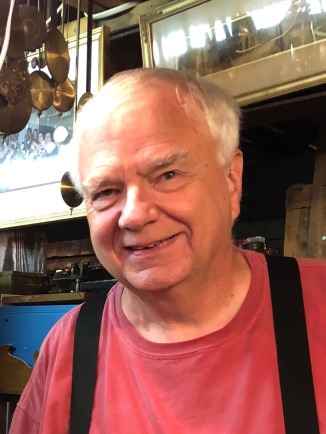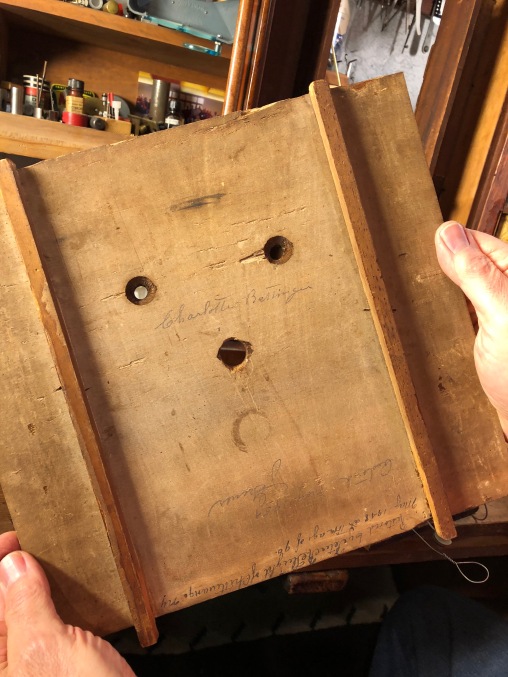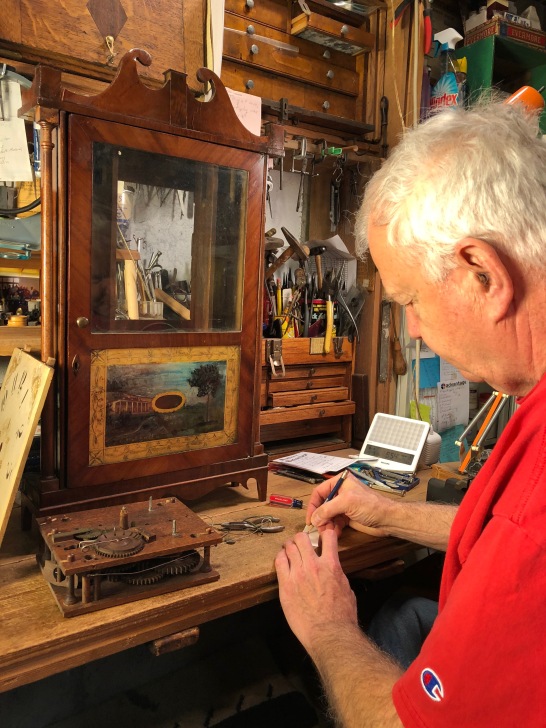By Sandra Hutchinson

Early this spring, I attended an auction in Washington County, New York, with the intention of bidding on a Federal mahogany console table for my front hall. While at the preview, I noticed a shelf with several clocks that were to be included in the auction later that evening.

The Federal table that prompted me to attend the auction. Photo taken at auction preview.
One clock caught my eye. It was meant to sit on a shelf, appeared to be of mahogany veneer on the front, had a glass door with a reverse painting of George Washington’s Mount Vernon on it, and was topped by three brass finials. I asked the auctioneer about it. He told me it was a clock probably made around 1820, by Connecticut clock maker Eli Terry, called a “Pillar and Scroll” clock. He said the estate from which the clock came had indicated the clock had been operating prior to being put up for auction.
Now, what I know (or, more correctly, what I knew then) about antique clocks wouldn’t even fill a paragraph on this blog. But after seeing the clock, I had a few hours between the preview and the auction, so I did a little research.
I learned that Eli Terry (1772-1852) was the first American clockmaker to mass manufacture clocks in a way that made them affordable, enabling ordinary citizens to purchase them. Writes the New England Historical Society, “In 1815 Terry transformed the clock market with the Pillar and Scroll Clock. This handsome clock had a 12×12-inch face, a beautiful reverse glass painting on the door and 20-inch pillars on each side with a fancy carved scroll on the top. The Pillar and Scroll clock sold for about $15, and was distributed from door to door and town to town by Yankee peddlers on wagons.”
The Historical Society also writes: “Terry’s two sons Eli Jr. and Henry also took up clock making, and in 1823 he established Eli Terry & Sons. At first, clocks were produced at a rate of about 6,000 a year, which increased dramatically to 10,000 and then 12,000. Eli Terry, Jr., left the firm in 1828 and moved to eastern Plymouth, where he built a new clock factory. He produced shelf clocks until his death from overwork in 1841.”

Eli Terry certainly looks serious.
I also did some online searches to determine the possible value of the clock. I did find auction references to pillar and scroll clocks, but the prices varied widely, depending on condition, from a couple hundred dollars to thousands. I also found various parts and pieces from Eli Terry clocks for sale, such as the brass finials.
I’m not sure what possessed me when the clock came up for bid that evening at the auction, especially since no one else initially bid. I think my first bid was in the ballpark of $100 or so. I thought to myself, “Well, the worst that happens is I have an interesting, historic clock that doesn’t work!” Suddenly, another bidder raised his bid card. Ok, maybe I wasn’t an idiot after all, bidding on this thing. That person and I bid against each other for only two more bids (well, then again, maybe I was an idiot), and the gavel came down at $400. OMG. What had I done?
I paid and then collected my clock, stupidly not realizing that I should have taken the two heavy weights out of the case while carrying it to my car, as well as the brass finials, which were simply stuck into the top on wooden pegs. I laid it on its back on the back seat of my car, padded around it with blankets (I had brought these to cushion the table, on which I had also successfully bid), and off I went.
After I got the clock home, I put it on a table and examined it. Inside the clock was a paper that said the clock was invented by Eli Terry, and made in Plymouth, Connecticut, by Eli Terry, Jr. There were cords that appeared to be meant to attach to the weights and there was a brass winding key inside the case, but I had no idea what to do with the thing, and I was afraid of messing with it. So I called the auctioneer and asked whether he knew anyone who might work on this type of clock. He referred me to a man named Peter Elmendorf, of Saratoga Springs, NY (just down the road from my home).
I called Mr. Elmendorf, and told him that I had purchased the clock at an auction. He asked “Why did you do that?” Oh dear. I told him that I thought the clock was beautiful and that I had been told it had been working prior to being put up for auction. He said he would look at it, and that I should bring it to his workshop at his home. We arranged a time, and off I went with my clock.
Being in Mr. Elmendorf’s clock workshop in his home’s basement felt a bit like being in Santa’s workshop where the elves are working on many projects at once, with bits and pieces of clock works, gears, winding keys and pendulums spread all over.

Turns out, Mr. Elmendorf is president of his chapter of the National Association of Watch and Clock Collectors, teaches clock repair through his local continuing education program, and collects Ogee clocks, made in the mid 19th century. Many in his collection feature paintings of historic Saratoga Springs buildings, landscapes and scenes. Looks like I found the right man for the job.

Mr. Elmendorf opened up the back of the clock in front of me, to see what he was dealing with.

Incredibly, inside was written a name “Charlotte Bettinger,” which presumably was a previous owner of the clock — maybe the first? On another part of this panel were written two other names, with dates, indicating people who had repaired or worked on the clock. One said “Restored by Peter R. Sleight of Chittenango NY May 1948 at the age of 90.” The other writing said “Restored May 1954” and a signature which appeared to be J. Griner or Grimer. I asked Mr. Elmendorf if he wrote his name and date inside clocks on which he worked, and he said he did not.



Mr. Elmendorf writing out a receipt for my clock before I left it with him, “in case something happens to you or me.”
Even though my clock is of an earlier vintage than what he usually works on, and has wooden gears and works (in contrast to brass works), Mr. Elmendorf said he believed he could fix my clock, and he gave me an estimate of cost which was extremely reasonable. When he told me the clock had the original chime and pendulum, I was thrilled. I gave him my thanks and blessing, and off I went.
I talked with Mr. Elmendorf periodically over the next several months, as he worked on the clock. There turned out to be many challenges, and at one point he was unsure whether he could get it working properly. I told him I was patient, and that he could take all the time he wanted. When I got the call that it was ready and working, I excitedly drove down to pick it up. The video below includes some of Mr. Elmendorf’s instructions to me on how to transport the clock, properly insert the weights and adjust the clock hands.
Once I got the clock home, I positioned it in a safe place, carefully wound it, and tentatively started the pendulum ticking. It worked for a while…..and then it stopped. Each time I wound it, it would run from anywhere to a few minutes to a few hours……and then stop. I called Mr. Elmendorf, he generously offered to make a house call, and after opening it up and examining it, he took it back to his workshop. He assured me I hadn’t done anything to harm the clock.
After another couple of months, in late October, I heard from Mr. Elmendorf again. He told me he had diagnosed the problem with the mechanism, and the clock had been working and keeping time for three weeks in his workshop. I drove down and picked it up.
The clock has been keeping time now for about a month. I wind it each morning, and find it generally runs for about 26 hours. We love hearing the chimes, and for the first time we know what time it is in the middle of the night when we can’t sleep, without having to check a clock on the nightstand. Our dogs still startle when the chimes begin, but we’re hoping they will acclimate. And we are so grateful to Mr. Elmendorf for his skill and patience and perseverance in making our clock work. We are keeping our fingers crossed.

Fascinating and very interesting, Sandy! Bravo! Love blogs like this!
LikeLike
Thanks Gordon! Let’s just hope it keeps on ticking!!
LikeLike
Love both the table and the clock! A very interesting blog – pictures added so much. Thanks!
LikeLike
Hi Mary Ann! Thanks for reading. Hope all is well down south!
LikeLike
What a marvellous story, I also love old clicks especially if the chime.
LikeLiked by 1 person
Well we shall see how long it runs!! We are keeping our fingers crossed. Thanks for reading. Love your posts Marion. You are on the move!!
LikeLiked by 1 person
I loved this story about your Eli Terry clock. We have one, too, recently acquired by auction. It also has wooden works and looks much like yours. Thanks for sharing. You have given us hope that our clock can run again!
Kathlee Rose
LikeLike
Thanks Kathlee. We love our clock! Let me know if you get yours to run! What is the image on the door of your clock?
LikeLike
Sandra , thanks for the story . Wonderful. We have a duplicate of your clock and it has a broken tooth in one Gear . I would like to ask your clock maker if he trained or knows of a clock maker near Pittsburg Pa who could fix our clock also . Can you give me his contact info , please ?
Rick And Sally Mowrey
412-417-1092
LikeLike
Hi Rick. Peter Elmendorf’s email is fixclocks55@gmail.com. He’s in Saratoga Springs, NY. Let me know how you make out. My clock has had a few bumps along the road but it’s now working well. We love it. Thanks for reading my blog.
LikeLike
Thank You Sandra . I have e mailed him and we will see . I will keep you informed
Rick
LikeLike
Peter helped me find a clockmaker in Pittsburgh Pa
Thanks
LikeLike
Great news! Maybe you can send a photo of your clock to me? Would love to see a sister clock to mine. Not sure if you can include a photo in this comment section. If not, email: chronicle@loneoak.com. Thanks!
LikeLike
Great story and photos! Thanks so much. I own a similar Terry clock that I inherited from my aunt, who died in 1999 at age 93. The clock was made in 1830 and still works! I love its tik-tok sound and gentle bell strike. I remember it always being on a shelf in her hallway whenever I visited my aunt’s home, starting as a boy in late 1940’s to early 1950s. It’s now on a shelf in my home office. Similar to your experience, when it needed some adjustments in 2012, I removed the wood face board and on the back were hand-written “1955 My clock: Mary (+ my aunt’s surname)” and below that was written “Arthur W. (surname) September 16th, 1886”. In 1886, the clock would have already been in use for over 50 years! If only clocks could talk.
LikeLike
Just read and watched your description of your beautiful E Terry pillar and scroll clock. Very nice. Just purchased my first pillar and scroll. Henry Terry (son of Eli) and am excited to get it. Thanks for sharing.
LikeLike
Thank you Aaron for reading my piece. Congratulations on purchasing your clock! Is it working? Where did you find it? What’s the image on the front? Enjoy it —they are treasures!
LikeLike
Thanks so much for the article! I have one as well. The same one you have. This has been in our family for 4 generations and I am thrilled to report is is safely ensconced in our dining room after Dad passed last month. I had the same problem. It would stop after 45 min to an hour or so. My Dad, engineer by trade, figured out the clock needed to be perfectly level. I have a mini level in the clock. Now there is a dime under one of the legs. Antique clock guy told me the sound needed to be that clear “tick tock” and the swing had to be an even 50/50. In the event you ever need to move your clock I do hope this helps! I, like you, find this clock gorgeous! Thanks for your blog. Most helpful to me and my new-to-me clock!
LikeLike
I need help with my Eli Terry weight clock.
LikeLike
Have almost identical clock, but was made by Riley whiting and is about 6 inches taller
LikeLike
Interesting! Was he based in Connecticut?
LikeLike
Seems he worked with Eli Terry.
LikeLike
Afternoon…
Thank you for saving this marvelous piece of American history.
These are wonderful old clocks, a “Pillar & Scroll” has been on my most-wished-for for many years…
LikeLike
Thank you! It’s actually working again after having a tune up but I only wind it occasionally so I don’t stress the works! Appreciate the feedback.
LikeLike
I received my Terry when my uncle passed at 100 years of age. I had always thought it was the most beautiful clock I’d ever seen. Sadly, it was not working when I received it and it has been in “clock hospital” with a wonderfully talented local clocksmith for a few months. Today brought some great news…the Terry is out of intensive care and on its way to good health! We are so excited to have found someone so talented that our Terry should make a full recovery. Ours looks very much like yours! They truly are such beautiful clocks!
LikeLike